
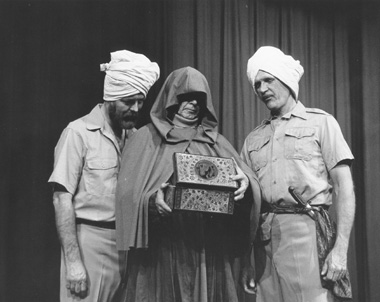
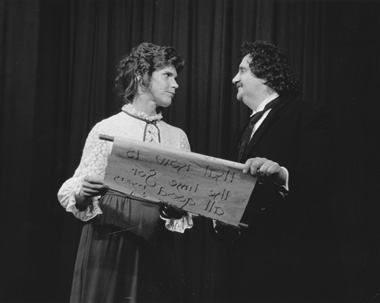

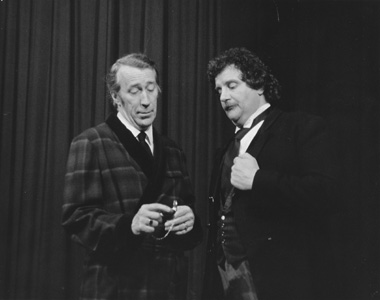


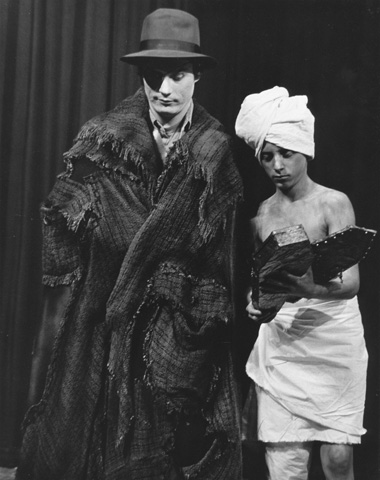
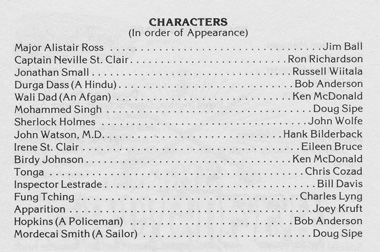
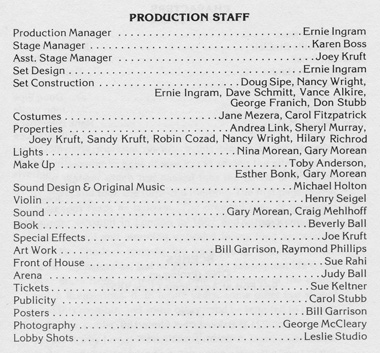
George McCleary
Driftwood Players
"The Crucifer of Blood" April - May 1985
By Paul Giovanni, Directed by Gloria Ingram
|
|
|
|
|
|
 |
 |
 |
 |
 |
 |
|
Pictures by George McCleary |
|
From The Daily World, Sunday, April 28, 1985
The Driftwood Players production of "The Crucifer of Blood," which opened Friday night is a dazzling display of technical wizardry embellishing a bizarre plot and characters, wrapped up in dialogue a la Arthur Conan Doyle. It's perhaps the most spectacular production ever for the local theater group.
This is vintage Sherlock Holmes -- but not written by Doyle. The playwright is Paul Giovanni, and he has "borrowed" characters and plots from several of the great Victorian sleuth's adventures and clothed them in Holmesian dialogue to produce this mystifying melodrama.
John Wolfe and Henry Bilderback, who played adversaries several years ago in the contemporary mystery "Sleuth," are teamed as Holmes and his faithful friend Dr. Watson. Both are excellent; Wolfe sharp, swift and incisive; Bilderback sentimental, kind, and sometimes a little foolish.
The entire cast does very well, but the sound track and spectacular special effects of this play deserve billing equal with the two leading actors, for much of the play's horror and suspense are due to the work of Ernie Ingram, production manager and set designer; Gary and Nina Morean in the lights and sound booth, and Joe Kruft, implementing special effects.
Adding immensely to the emotional impact throughout is the sound track, complete with original music, jackal howls, thunder and a raging rainstorm, that Michael Holton of Seattle made for the Intiman Theatre's production two years ago.
No fewer than five sets are brought out in full view of the audience by stagehands garbed like Indian servants.
They include a gate of the Red Fort at Agra, India, during the Great Rebellion against the British in 1857; the almost-familiar Baker Street lodgings of Holmes and Watson, a country estate in England in a crashing thunderstorm; an opium den where drug-induced apparitions appear and disappear in mist and flashing lights, and a foggy dock scene complete with moving boat.
We are not about to give away any nuances of the incredibly complicated plot (director Gloria Ingram has seen to it most effectively that almost no one is going to guess the denouement). Suffice to say that each person does his or her part to intensify the effect.
Eileen Bruce has the only female role, that of the young and lovely Irene St. Clair, who first brings Holmes into the tangle of intrigue, betrayal, greed, revenge and gruesome murder. Her part calls for swift changes in mood, and she meets the challenge convincingly.
Others involved are a British major, played with just the right touches of upper-crust nastiness by James Ball; his selfish and greedy captain, Ron Richardson (who was especially effecting as an old man); a non-commissioned British officer portrayed almost sympathetically as the best of a bad lot by Russell Wiitala; a philosophical Hindu soldier well done by Bob Anderson, and an Afghan soldier portrayed effectively by Ken McDonald.
McDonald also shows up very well in his second role, that of the major's bullied butler. Bill Davis is a suitably maddening pompous and jealous inspector Lestrade.
Vital to the play, but seen only very briefly, is Chris Cozad as an Andaman Island pygmy; Doug Sipe has two small roles as a leper and as an American sailor, and Joey Kruft plays an "apparition."
We aren't even going to mention the Chinese opium den proprietor, and there's a good reason for that. But, as we said, we aren't telling.
The above list of characters should give a clue to the complexity and bizarre twists of the plot, which jumps from India in 1857 to Holmes' study in 1887.
See it; you'll like it.
Home Driftwood Players Inc. Webmaster Larry Tingwall